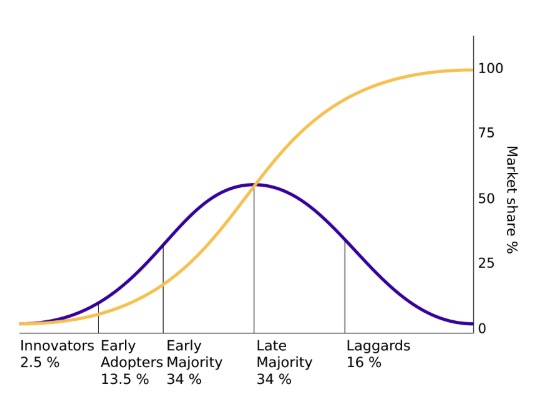Think back on some of the most impactful digital marketing technology to hit the mainstream over the past two decades. Search engines. Customer relationship management tools. Twitter. Were you one of the first to join and master these platforms, or were you late to the party?
There’s no shortage of companies that classify themselves as “innovative,” but the reality is that less than 200 early adopters paved the road for digital marketing to evolve into what it is considered today: normal, industry-standard marketing. These early adopters were the first to subscribe to new tools and ideas that had the potential to disrupt markets and provide a competitive advantage. They tended to be open-minded, active within industry communities, well-spoken within their fields of expertise, and unafraid of failure.
The concept of early adoption was first addressed by a theory called the “Diffusion of Innovations,” popularized by Everett Rogers in his 1962 book. Rogers classified individuals or groups into five categories: Innovators, Early Adopters, Early Majority, Late Majority, and Laggards.

In the graph above, the normal distribution in blue shows the percentage of Innovation adopters by category, while the yellow curve shows the aggregate market share progression of those groups.
Rogers’ theory makes many classical claims about each category in reference to age, prosperity, community connection, risk appetite, education, and authoritative influence.
INNOVATORS
Very young in age
Very prosperous
Well-connected to the community
Highest risk appetite
High level of education
Heavily respected as an authority within the community
EARLY ADOPTERS

Young in age
Very prosperous
Well-connected to the community
High risk appetite
Highest level of education
Highest respect as an authority within the community
EARLY MAJORITY
Older in age
Prosperous
Connected to Early Adopters community
Medium risk appetite
Medium education
Some respect within the community
LATE MAJORITY
Older in age
Somewhat prosperous
Connected to Early Majority community
Low risk appetite
Low education
Low respect within the community
LAGGARDS

Oldest in age
Low prosperity
Low connection within the community, if any
Very low risk appetite, if any
Low education
Low respect or not known within the community
Wow, some of that seems harsh! Maybe there’s more to the story?
These categories were first created in the 1960s, a time long before the Internet and the digital revolution. In the modern day, I’d insist on the following caveats:
“Education” has taken on a different meaning. Back in the day, the only recognized way to become knowledgeable about a topic was through a higher-learning institution. But today, some of the best developers and tech experts in the world don’t have a bachelor’s degree. In the spirit of modernizing this theory, it is probably wise to equate “education” with expertise in relevant knowledge domains.
“Age” does not necessarily refer to years of existence. It may be true that from an individual perspective, younger tech experts are usually more inclined to adopt a newer approach to solving a problem. But does this hold true for a company’s “age” based on its number of years in business? Sure, we hear about contemporary, innovative start-ups pushing for new paradigms, but even though Google isn’t adolescent in years, it would still be considered an innovative leader. An example outside of the tech world is Walmart and its cutting-edge applications of information systems that began in the mid-1980s (when the company was already over 20 years old). In this sense, it might make sense to think of “young in age” as a willingness to introduce change or new ways of working.
Caveats aside, there are some timeless and valuable lessons to be learned from this theory, namely around prosperity and risk.
“Prosperity” speaks, in part, to available opportunity. Unsuccessful organizations are less likely to have the capital to sustain a high risk appetite, and thus experience more friction when attempting to move to earlier categories of the curve. And some Early Adopters are prosperous not because of innovation adoption, but because of earlier successes or infusions of capital that allow them to take on more risk.
In terms of “Risk Appetite,” consider Brene Brown’s modern wisdom: “There is no innovation and creativity without failure. Period.” If you don’t know Brene, she’s a badass deliverer of tough truths. Risk implies the possibility of failure, and this shouldn’t be feared. It may feel uncertain and scary, but failure is one of the most important parts of innovation. Failure is progress, and it should be treated as a constructive investment. Failure can be learned from and reveal new opportunities. Organizations that promote a culture that accepts constructive failure are more likely to obtain competitive advantages through innovation. Companies that fear failure are more likely to find themselves at a disadvantage; technology moves too fast to plan on a long term status quo.
So early adopters are good, and late adopters are bad?
For a business, yes. Technology is everywhere, and flourishing industries tend to be intertwined with it. For a company to avoid being left behind by adversaries, it needs to have some semblance of observance towards riding the tech wave as it matures and unfolds.
However, when it comes to individuals, I just don’t think it’s that simple. As a developer, I have worked with professionals that are eager to adopt new tech as well as those who are more conservative and set in their ways. I have seen greatness on both sides of the spectrum. It is fascinating to observe the contrast in how these different kinds of thinkers approach problems and craft solutions. Though their methodologies may be divergent, diversifying a development team with resources that fall into different innovation adoption classifications can result in a strengthening of the entire team. With the right blend of professional respect and active listening, they have the capacity to shed new light in unlikely places.
There is strength and opportunity in diversity of perspective. It feeds imagination; the very essence of invention. What’s more innovative than that?

Want to know what kind of adopter you are? This quiz is a fun place to start!